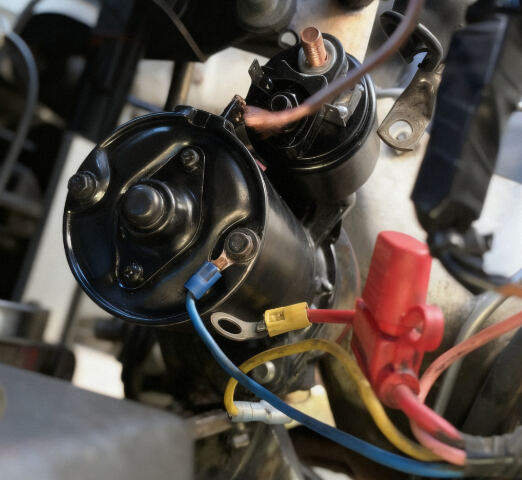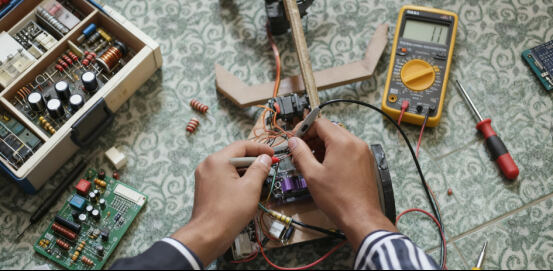How to test a starter motor solenoid?
The contents of the table |
| Key points |

If you follow the correct steps, you can inspect the starter solenoid. Always use the proper tools and ensure safety during operation.
Some safety tips are:
1.Wear safety equipment
2.Disconnect the power supply before starting the machine
3.Ensure the work environment is well-lit and dry
Digital multimeters and modern testers can help you obtain accurate results. Issues such as poor grounding, low battery power, or corrosion often cause solenoid problems.
1.Key points
1.Before testing, wear safety gear and disconnect the battery cables to ensure safety.
2.Use a multimeter to check the battery voltage. Ensure it reads at least 12 volts to verify your testing is accurate.
3.Carefully perform a bypass test to determine if the solenoid is faulty. If the engine starts cranking, the solenoid may need replacement.
2.Preparation and Tools

What do you need?
Before starting to test the solenoid, prepare all your tools. Having your tools ready makes the job easier and safer. Here's what you should have:
1.A multimeter to check voltage and continuity
2.A test light to see if power is reaching the terminals
3.Jumper cables for bypass testing
4.A screwdriver for removing covers or making connections
5.Safety gloves to protect your hands
6.Eye protection to guard against sparks or debris
Tip: Keep your tools organized and close at hand. This helps you work quickly and avoid mistakes.
Safety tips
Safety is very important when working with electrical parts. You need to do these things to keep yourself and your car safe:
1.Disconnect the vehicle's battery before starting work. This prevents electric shock and short circuits.
2.Wear insulated gloves and safety glasses. These protect you from contact with live wires.
3.Ensure your work area has fresh air and no flammable materials nearby.
4.Do not work in damp conditions. Water increases the risk of electric shock.
5.Remove all metal jewelry. Rings and bracelets can conduct electrical current.
6.Before reinstalling the battery, verify the battery ground connection is secure.
7.Ensure the ignition fuse is functioning properly.
8.If necessary, press the thermal cutoff button to reset it.
Remember: Following these safety steps prevents injury and damage. Always inspect your setup before testing the starter solenoid.
3.Testing the Starter Solenoid
Video Source:@TightWadDIY
Find the starter solenoid
You must first locate the starter solenoid before testing it. In most vehicles, you'll find it mounted on or near the starter motor. Look for a small cylindrical component with wires connected to it. Sometimes it's positioned on the side of the engine compartment or near the battery. If unsure, consult your vehicle manual for the exact location. Ensure the area is clean and easily accessible.
Initial checks
Start by quickly inspecting the solenoid and its connections. You want to identify any obvious issues before using any tools. The table below can help you know what to look for:
Sign |
Description |
Loose Wiring |
Wires that are not securely connected |
Corrosion |
Rust or oxidation on terminals |
Worn-out Components |
Parts that show significant wear |
After you check for these signs, try to listen for sounds when you turn the key. The noises you hear can tell you a lot about what is wrong. Here is what you might hear and what it means:
Sound Type |
Meaning |
Rapid clicking |
weak battery or poor connections |
Single loud click with no crank |
solenoid engages, motor may be stuck or worn |
Whirring without cranking |
starter gear not engaging the flywheel |
Grinding while cranking |
worn starter gear or damaged flywheel ring gear |
Silence |
check immobiliser, starter relay, ignition switch, or neutral safety switch |
Tip: Clicking noises often mean a weak battery or bad connections. If you hear a single click or repeated clicks, check the battery terminals and cables.
Battery voltage test
Before starting to check the starter solenoid, the first step is to see if the battery is charged. If the battery power is insufficient, all your subsequent tests will be in vain and the results will definitely be inaccurate.
First, measure the battery voltage:
1.Take out a multimeter and set it to the DC voltage range (the one marked "V-" or "DCV").
2.Touch the positive terminal (+) of the battery with the red test lead and the negative terminal (-) with the black test lead.
3.The reading must be at least 12 volts. If it's below 12 volts, don't worry about anything else. First, charge the battery or get a new one. This is the foundation of all tests.
Next, use a multimeter or test lamp to check the starter solenoid:
If a multimeter is used:
1.Set the multimeter to the on-off mode or the resistance mode.
2.Find those several terminals on the solenoid valve.
3.One test lead is connected to a reliable ground wire (that is, to the negative terminal).
4.Touch the terminal you want to measure with the other test lead.
5.If the multimeter shows "open circuit" (no response or shows "OL"), then what you have found is that brown terminal.
6.If you see a high resistance value (but not an open circuit), then what you are encountering is a yellow or blue terminal.
It is more intuitive to use a test lamp
Clamp the clamp of the test lamp to a reliable ground wire, and then use the probe to touch the terminal of the solenoid valve. At this point, if you ask someone to turn the key and light the fire, the test light should come on. If the light doesn't come on, the problem might not be with the solenoid valve itself, but rather a blown fuse, a broken ignition switch, or poor contact of the ground wire.
Don't rush at every step. Take it slow. Only by conducting a thorough examination can the root cause of the disease be truly identified. This way, it saves both time and money.
Briefly summarize the process:
1.Get your tools ready and pay attention to safety.
2.First, check the battery and the connection of the circuit.
3.Then, use a multimeter or test lamp to measure step by step.
4.If the situation requires, you can try bypass testing (remember to take proper precautions).
5.Finally, be sure to take several tests to confirm the results. If you are not sure about yourself, don't force yourself. It's safest to seek help from a professional master.
4.FAQ
If the solenoid valve of the starter malfunctions, what are the typical signs of a car?
You may notice that when starting up, you only hear a "click" sound, but the engine doesn't respond at all and won't turn. Sometimes the car lights will also dim significantly. These situations are mostly a reminder to you: It's time to check the solenoid valve.
Can the solenoid valve be tested directly without disassembling the starter?
Sure. With a multimeter or a test lamp, it can be measured at its original position without being removed. However, before taking action, be sure to take safety measures first, such as cutting off the power and applying the handbrake. Proceed step by step.
Is it safe to start directly bypassing the start solenoid?
Temporary tests are fine, but be sure to take good precautions - wear gloves and goggles! And keep your body away from the moving parts in the engine compartment to avoid accidental injury. This method is only recommended for identifying problems and should not be used in this way for a long time.








